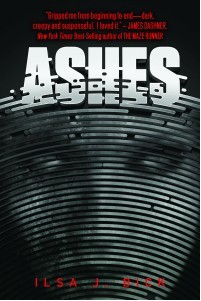 Ashes by Ilsa J. BickEgmont, 2011 The publisher summary of this novel had me at electro-magnetic pulse. Finally, a post-apocalyptic YA novel with an EMP! Honestly, if I was an evil genius, that's definitely what I would unleash upon the unsuspecting populace. Imagine the chaos! The destroyed infrastructure! Civilization would be booted back to the Middle Ages. Indeed, while 17-year-old Alex is on a long September hike in the Michigan wilderness to finally spread her parents' ashes, an EMP (Alex calls it "the zap") detonates, killing all people except for the young and the elderly and destroying virtually all electronic devices. After Alex strikes an uneasy truce with 8-year-old Ellie whose grandfather died during the zap, the two of them head off in search of assistance and shelter with Ellie's dog Mina in tow. Armed with Alex's wilderness survival expertise, Ellie's fishing skills, and Mina's protection from wolves and other wildlife, survival looks doable. Neither they nor I were expecting the zombies. It turns out that the zap somehow turned some of the surviving teenagers into unnaturally fast cannibalistic monsters, and Alex is now waiting to turn into one herself. Instead, her sense of smell seems to be hyper-sensitive and she wonders if that has to do with the inoperable brain tumor she has recently refused further treatment for. Nonetheless, surviving in the increasingly colder forest while avoiding zombies and packs of wild dogs are keeping Alex and Ellie busy, and with winter fast approaching their plans - and potential partnerships with other survivors - literally become matters of life or death. Admittedly, I was a bit dubious when the zombies came into play. As a rule, I feel that a relatively (sometimes deceptively) simple plot with well-executed and complex characters can make for a very satisfying read, certainly more than a complex plot with simple characters. I feared that the zombie teenagers would be one plot element too much and would take over the story and push it into the realm of unbelievability. However, Bick didn't allow that to happen: the zombie angle was not overused, and in fact the most frightening characters in the book were - appropriately - other survivors. Bick's main characters are pleasingly complex. Alex is fiesty and brave but also soft-hearted and very clever. Ellie was so well executed that there were times I felt like wringing her neck as much as Alex did, although I did feel as though she often seemed older than her very young age due to her frequent use of sarcasm. Later characters were also far more than one-dimensional, and I very much look forward to their development in future books. Yes, Ashes is the first book in a trilogy, and as such has one hell of a cliffhanger ending. (My summary covers perhaps the first 20% of the book, so a great deal happens that I didn't specifically touch on so as not to spoil anything - it's a thriller after all!) I don't know how long I'll need to wait for the second instalment, but I certainly hope it arrives sooner rather than later. **Electronic review copy provided by publisher via NetGalley.
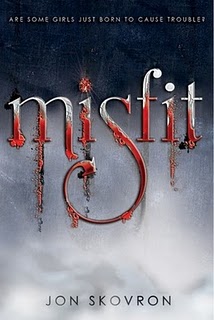 Misfit by Jon SkovronAbrams, 2011 Jael’s sixteenth birthday is approaching and she is not quite sure what to expect. She and her father have abruptly moved from city to city and country to country for her entire life, and she desperately hopes that the talk he wishes to have with her on her birthday has nothing to do with picking up and leaving yet again since she’s finally found a couple of good friends. She is also anxious to know more about her mother, who died when she was very young. Jael’s life changes forever when her father gives her a jewel handed down from her mother and which has mysterious powers. Over the next few days, Jael discovers that not only was her mother a demon, but that Jael herself is half demon with most of Hell hunting her because she is a reviled half-blood.
Misfit started off slow and initially appeared fall into a predictable "teenage girl doesn't get along with her strict single father until some sort of major event brings them closer together" storyline. Although to a certain degree Misfit indeed progressed in that way, it did it in a fun, entertaining, and largely unexpected fashion.Skovron's interpretation of demons is inventive. He draws connections between different religions and cultures to paint a complex picture of demons (many previously known to mortals as gods and goddesses), and the classical elements of nature play a large role as well. In fact, one of Jael's newfound skills is the ability to communicate with the different elements, all of which have different characteristics and which require convincing in different ways. I found this use of the elements, as well as Jael's heightened demon perception and other skills, to be creative and not overused for the sake of entertainment value.The characters in Misfit were complex and enjoyable. Jael's father was not the one-dimensional stereotypical "strict father" figure that he initially appeared to be. His personality came out mostly during the flashbacks to his time with Jael's mother rather than in the present with Jael, but it worked. Jael's friends Britt and Rob are also more than they initially appear, and the dialogue between the teenagers combined with scenes with Jael's demon uncle Dagon provided lots of humour. Overall, despite a slow start, Misfit was an engaging fantasy with an inventive interpretation of demons, fun characters, and lots of action and humour. Highly recommended. **Electronic review copy provided by NetGalley.com.
 Imaginary girls by Nova Ren SumaDutton, 2011Chloe's older sister, Ruby, is someone who gets whatever she wants whenever she wants it. Although most people would find this a difficult shadow to live under, Chloe adores Ruby like everyone else and appreciates her protectiveness, especially after Chloe finds a girl's body in a rowboat while attempting to swim across the town's reservoir and is haunted by the discovery. Only after returning to live with her sister after a two year absence does Chloe sense that something is off about her hometown, as well as with Ruby - not least because the girl she found dead appears to have been resurrected. Imaginary girls is a beautifully-written book. Suma uses language in inventive ways that rolled wonderfully off my tongue. Phrases like "the wind billowing up inside her translucent dress and spooling out her dark hair"* and "the night stars peppering my skin" appeared throughout the novel and were always surprising. I often read sentences twice to enjoy them once again. Despite the beauty of the language, I felt a constant disconnect with the characters and events in the book. At no point did I really care about what happened to Chloe or Ruby, and this was regardless of the constant sense of foreboding that permeated the story. There were many times that I looked at the bottom of the Kindle page to see how far along I was, and frequently I wished that I was closer to the end. I feel that the story lacked an intimacy and connection to the characters, likely because there were so few truly intimate moments within the story. Even during close moments shared between the sisters, knowing how manipulative Ruby was I constantly questioned her motives. As well, Chloe recounts the tale with a distinct sense of distance which adds to the disconnect. However, perhaps this was Suma's intent all along: Ruby, very clearly the focus of the novel, is cold and lovely, much like the telling of the tale. If Suma wanted to reflect the distance and beauty that Ruby exudes, then she certainly succeeded. Indeed, even the cover (which is stunning) reflects that sense of icy loveliness. If this was Suma's goal, then Imaginary girls is most certainly a success. *I read an electronic galley, so I have no indication of what pages any quotes will appear on in the printed volume.**Electronic galley provide by publisher via NetGalley. Book to be released June 14, 2011.
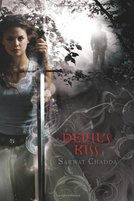 Devil's kiss by Sarwat ChaddaDisney Hyperion, 2009Billi SanGreal is the newest, youngest, and only female member of the Knights Templar, who are responsible for defending London from supernatural evils. Her father is the Master of the Templars and rules with an iron fist, especially since Billi's mother was killed over a decade ago. When Kay, Billi's childhood friend, inadvertently opens a long-closed door to legions of dark angels, the Angel of Death is summoned and a plague of biblical proportions begins. I'd been looking forward to reading this book for a while. I had read the first chapter a few months ago during a quiet afternoon at work and it sucked me right in. With a fantastic first line - "Killing him should be easy; he's only six" (p. 3) - and the first chapter following it up nicely, I had high hopes. Unfortunately, Devil's kiss didn't quite live up to my expectations.The novel is chock full of information about the Knights Templar and their history, but after a rip-roaring first chapter, a second chapter inf0-dump was a definite let-down. As much as I liked learning little factoids about Templar history, I found the delivery clunky. Turns out that Chadda is great at writing action sequences though! As in the first chapter, subsequent scenes involving battles with supernatural beings ranging from angels to vampires to Satan himself were energetic and satisfying. Devil's kiss definitely starts and ends on high notes due to this circumstance. Despite the selling of a love triangle on the back cover blurb, it didn't really exist at all in the story. This was fine by me - I didn't read the back cover until I finished the book so I had no expectations that way - but the romance that did exist seemed tenuous at best. I wonder if the friendship angle would have been a more powerful and believable connection, especially as Billi didn't have any friends her own age. However, the ending hints at a sequel which may make Chadda's choice of romance more evident.I was disappointed in the lack of use of Billi's heritage in the story. While her father is presumably British, her mother was of Pakistani descent and I kept waiting for that to factor in to the story, either via some of the non-Christian beliefs in Asia or some other link. While part of me appreciates that her cultural heritage didn't sway things one way or another, another part of me wishes it could have been used more. Given the amount of information given about the Templars, a connection from them to the ancient cultures of Asia would have been welcome. Again, perhaps the sequel will explore more in that direction.Will I read the sequel? I can see it happening. As I say, Chadda's action scenes were great and I am curious about where he takes the Templar theme in the next book.
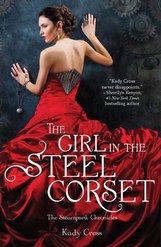 The girl in the steel corset by Kady CrossHarlequin Teen, 2011 It is the middle of the night in Victorian London, and Finley Jayne is fleeing from from her lecherous employer. When duke Griffin King practically runs her over with his motorized bicycle when she appears out of the darkness, he takes her to the home he shares with his close friends to ensure that she is okay. She soon proves herself to be physically fit when she flings a grown man across the room after awaking in a panic. Thus begins a tenuous friendship between Finley and Griffin, and when their special skills are revealed to each other - as well as to Griffin's friends Emily and Sam - it turns out that they are connected far more than they ever would have guessed and have a common enemy. If The girl in the steel corset is any indication of the genre, it turns out that I really, really like steampunk. This shouldn't be a surprise given that I adore dystopian fiction, historical fiction, and science fiction. It should have been a no-brainer. Nonetheless, more please! Kady Cross vividly describes the London of her imagination. With automatons performing household tasks and tiny portable telegraph machines that are basically the Victorian version of texting (clever!), as well as potent descriptions of odors and atmospheres, it was easy to fall into the story. And fall in I did, whipping through 477 pages in 2 days. Cross also switches perspectives often, from Finley to Griffin to Emily to Sam, which would sometimes drive me batty but is executed here with such skill that I actually liked it. The different points of view were often refreshing and provided valuable snippets of information, and I felt more connected to all of the characters as a result. Indeed, I found all of the characters to be very well developed and interesting, even secondary characters like Cordelia and Jack Dandy: not a cookie-cutter among them. True, The Machinist was a bit one-dimensional, but vengeance can do that to a person. I'm not saying much about the characters because I found much of the joy of reading this book was watching the characters revealing themselves to the reader as well as to one another, and the plot unfolds naturally and excitingly. My one complaint is that I got a bit sick of hearing about Emily's "ropey" hair, which is a phrase that appears more than 10 times during the book (one of the advantages/curses of electronic galleys is document searching). If that's my only issue, as far as I'm concerned it's a damn good read. About halfway through the book, it struck me that The girl in the steel corset is basically X-Men set in the late 19th century with robots. Finley, Griffin and their cohorts are mutants. Truly. They are never referred to as such, and the causes of their powers are clearly explained, but elements of comradery and fighting a common enemy are certainly there. Also like X-Men, it looks as if this is going to be a series and I will be keeping my eyes wide open for the second book in The Steampunk Chronicles.**Electronic galley provided by publisher via NetGalley.
 Forgotten by Cat Patrick
Little, Brown, 2011
Every morning, London Lane wakes up and cannot remember anything that has happened before. Not only is the previous day forgotten, but her entire life up to that point is unremembered. Reading letters that she writes to herself each night, each morning London gets caught up on what is going on in her life: school, friendships, and a very cute new boyfriend named Justin. The thing is, London can "remember" events that occur in the future - such as upcoming spring breaks with her best friend - but Justin doesn't appear to be there. When she begins dreaming of a funeral she fears that it may be connected to Justin, but how? And whose funeral is it?
Pros:
Fantastic premise.
Awesome mother.
Dreamy love interest.
Mysterious family history.
I loved the idea of amnesia combined with "remembering" the future, which is a helpful plot point in the sense that it allows London to know her mother and best friend. It also creates tension with London's dream of the funeral and working out when it happened and who died, as well as not knowing who Justin is because he's not in her memories of upcoming events. I found the beginning of the book to be confusing though, and didn't know what was going on with London and her memory for the first couple of chapters. I imagine that it would be obvious if I re-read those chapters, but when I wasn't familiar with London's situation I found it confusing.
For the most part, I liked London: she could be a bit dramatic for my taste at times, but if I couldn't remember my past I'd be sensitive to trust issues as well. She must also get up ridiculously early if she manages to read all her notes every morning! Her mother was solid and amazingly patient, and watching London repeatedly adjust to Justin's presence - it must be very odd to be in a relationship with someone you only know from notes you wrote - was entertaining.
Speaking of the notes, I appreciated how Patrick addressed the malleability of the present in London's life. For example, London can see how an acquaintance of hers will get hurt after dating a specific boy, so she works with what she knows to try to save her from that fate. Because she is so reliant on her notes, if London doesn't write down specific things about her day she will never know what happened or didn't happen. Seeing London play with this knowledge, which was a way for her to have power over her situation, was fascinating and produced unexpected results.
Cons:
London sometimes sounded like a 80-year-old.
There were a few passages that jolted me right out of the story, such as "the wind sets flight to my bright auburn locks" (p. 8 of galley) and "the thought of [Justin] serving as older brother to these two precious ladies feels right" (p. 73 of galley). What 16-year-old uses the word locks instead of hair? To say nothing of calling 2-year-old twin girls "precious ladies," which I'm guessing may come from the author being a mother of twin girls. Although I'm sure both the author's daughters and Justin's sisters are indeed precious, I have a lot of trouble believing that a teenage girl would string that particular phrase together.
All told, Forgotten is a compelling debut from Cat Patrick and I look forward to more books from her in years to come.
**Galley provided by publisher.
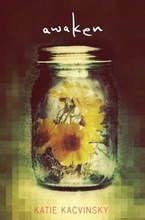 Awaken by Kate KacvinskyHoughton Mifflin Harcourt, 2011It is the year 2060, and Madeline is seventeen and in her final year of Digital School (DS). In fact, her father is the creator of DS, which allows all American children to have free education via computers in the comfort of their own homes, and even adults socialize and work entirely online. Madeline's father doesn't make her life easy due to an anti-DS incident that happened when Madeline was fifteen, so she has a probation officer and is under constant surveillance. When she meets the mysterious Justin at an offline study session, she has no idea how much the life she takes for granted is about to flip upside down. I had a great time reading Awaken. For one thing, I have a particular weakness for dystopian literature so this was right up my alley. What I found interesting was how similar Kacvinsky's imagining of 2060 is to today's world and that it initially threw me off a bit. I'm so accustomed to scenarios set 50 years into the future being full of flying cars (which actually show up but as a surprising invention and not a daily occurrence) and helpful household robots that the subtlety of Kacvinsky's vision was initially a bit of a let-down. However, it grew on me and is ultimately far more realistic and made the cultural developments that much more stark. It also allowed for one my favourite scenes in the book, in which Madeline encounters real grass and trees for the first time in her life. Madeline has many firsts in Awaken, including first offline study group, first ride in a car, first time hearing live music, and first love. The vast majority of these firsts - if not all of them - are brought about by Justin, with whom Madeline is infatuated from the beginning. Madeline's inner dialogue about his friendship is entertaining and ratchets up the sexual tension, and combining that with watching Madeline and Justin warily circle each other and do their best not to succumb to their feelings made this one of the steamiest dystopian novels I can recall reading. As the Brits say, "Phwoar!" Awaken is populated with many compelling characters. Madeline's mother makes a strong early appearance and, while she doesn't play a large role, is an effective presence with her values that lean strongly toward the pre-digital. By contrast, Madeline's father plays his cards very close to his chest and is deeply invested in his work, and his relationship with Madeline is rocky at best. One of my favourite characters was Clare, a friend of Justin's who adds much-needed lightness to the proceedings, as does Justin's monumentally charming family. More than just a romance in a futuristic world, Awaken presents a vision of the future that may well come to pass and I will be handing it to fans of Uglies and Feed without hesitation. **Electronic galley provided by publisher via netGalley.
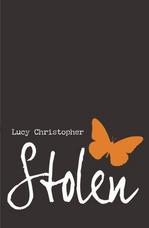 Stolen by Lucy Christopher
The Chicken House, 2010
On a trip to Vietnam with her parents, 16-year-old Gemma meets an attractive and vaguely familiar guy in a Bangkok airport cafe. What she thinks is an innocent flirtation quickly turns into a drug-induced blur that ends when she wakes up on a bed in a small room a few days later. It turns out that she's been taken to a remote part of the vast Australian desert and her captor, Ty, intends to keep her there with him forever.
Stolen is written as a letter from Gemma to Ty as she looks back on the beginning and development of their relationship, so as a reader I spent time in Gemma's head as the kidnapping and subsequent events occur but with the buffer of a reflective distance. This distance has an ebb and flow to it and while some events are told almost like a narrative, others are very immediate. To Lucy Christopher's credit, I didn't notice this flux as I was reading and was simply drawn deeply into the story.
What I find remarkable about Stolen is how the author managed to keep tensions high even when not much is happening. True, Gemma makes some dramatic escape attempts, but for the most part she is watching Ty's movements and slowly absorbing the situation she finds herself in. I found myself turning pages quickly to find out what happens next, and small things (like feeding the chickens) took on a lot of significance as a result.
Gemma's emotional journey throughout the book is wonderfully depicted. Her thoughts and feelings are on display and her actions reflect those internal struggles. Her relationship with Ty develops and his motivations and history are slowly revealed, and he is not in any way a cookie-cutter character. Both Gemma and Ty have a lot of dimension and complexity, and the stark and brutal Australian desert setting is a character in its own right.
My one criticism is that the end felt weak to me and almost like a cop-out (I won't spoil it for you though). I discussed this with a friend of mine who had recommended Stolen to me, and she made the considered point that it was the only possible conclusion. I beg to differ, however, and I feel like the book could have ended far more ambiguously. I will say that Gemma's emotional reactions at the end of the book were consistent and realistic, which I greatly appreciated.
While I've read a few books about teen kidnappings, this one has twists and complexities that I had not yet encountered.
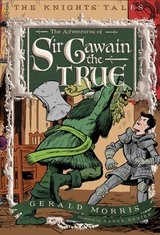 The adventures of Sir Gawain the True (The Knights' Tales, book 3) by Gerald Morris, illustrations by Aaron RenierHoughton Mifflin, 2011As a member of King Arthur's court, Sir Gawain is expected to be courteous and honourable. Unfortunately, despite his faultless record in tournaments, Sir Gawain has not quite been living up to expectations. When the mysterious Green Knight shows up at court during Christmas celebrations, Sir Gawain finds himself avowed to him and must keep his word despite the fact that it appears to mean certain death. This is the third book in Gerald Morris' The knights' tales series, although it is the first one that I have had the pleasure to read. Based on the 14th-century poem Sir Gawain and the Green Knight, The adventures of Sir Gawain the True makes the tale easily understandable to young students, which is not a characteristic of the original if I recall my university English courses correctly. The core of the classic story is kept - the Green Knight's challenge, the woman with her sash, the magic - and the addition of modern humor and charming illustrations certainly accentuate its entertainment value. I got a kick out of King Arthur as portrayed by Morris: he is determined to have his knights behave honourably and is very patient with them, but is occasionally exasperated. His reactions to his knights' lack of courtesy were often humourous, and his acknowledgments of improvement act as subtle cues to the reader that appropriate behaviour was displayed. After all, adventure aside, many Arthurian tales have morals and lessons within them and this version is no different. However, I didn't feel bonked over the head with a moral, and certainly Sir Gawain wasn't perfect from the beginning but manifested thoughtful and gradual change throughout the story. The tale itself is a lot of fun, with dwarves, reclusive lords, and jousting all coming into play. Morris' descriptions of period vocabulary, such as damsel and vow, are provided in the text in such a way that they provide information, history, and humour without really bringing the reader out of the story. As a fan of both language and history, I certainly appreciated his incorporation of both into the narrative. I am hesitant to discuss Aaron Renier's illustrations very much because I read an electronic galley on a Kindle and some of the drawings were split into two, which certainly detracted from my enjoyment of them. However, I did like what I saw despite the fact that Renier drew the knights and King Arthur as older than I envisioned them in my head, which took me aback a bit. That is my only critique (which should be taken with a grain of salt as ages and appearances were never discussed in the text) as the style and content of the illustrations were delightful. Morris managed to pack a legendary tale into a little over 100 pages which in itself takes great skill, to say nothing of the humour and charm of the text and illustrations. Although I've not read the previous two installments of this series, I will be seeking them out and looking forward to get my hands on them as well as any future books in The knights' tales series. **Electronic galley provided by publisher via netGalley.
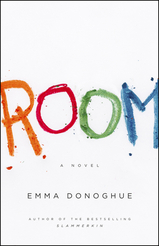 Room by Emma DonoghueLittle, Brown and Company, 2010The winner of a 2011 Alex Award as a book written for adults that has appeal for teens, Room is certainly not for the faint of heart.Jack has just turned five. He and his Ma live in Room, a fortified soundproofed outbuilding where his mother has been kept prisoner for seven years by Old Nick. Although Old Nick is Jack's father, Jack has never laid eyes on him as he visits only at night after Jack has gone to sleep in the wardrobe. Things take a turn for the worse shortly after Jack's birthday and Ma begins to make plans for escape, involving a reluctant Jack who can hardly get his head around the fact that a world exists outside Room, where he is happy and content. Room is told entirely through Jack's eyes, which makes for a fascinating perspective on both the situation he is in and how his mother reacts. As he doesn't know anything different, to him Room is as good as it gets. His perception of television is that it is transmitted from other worlds, and he truly believes that Dora the Explorer is his friend. Despite his naivete Jack is intelligent and is skilled at language. It is actually quite astonishing how diligent Ma has been in trying to keep him physically and mentally healthy in Room. Ma was young when she was kidnapped by Old Nick, and after seven years of captivity she is still only in her mid-twenties. She finally reaches her breaking point when Old Nick shuts off their power and heat for a few days and begins planning their escape. Jack trying to get his head around the outside world is an interesting process, and certainly Donoghue had her work cut out for her narrating from a five-year-old's perspective. There isn't much action in this novel, but what action there is I found extremely suspenseful. Room is far more about character and what people do to survive trauma, and seeing Ma struggle with newfound freedom and Jack trying to make some sense of the world outside Room - as well as the fact that he may sometimes be farther than a few feet away from Ma - was poignant. I believe that older teens will find much to capture their attention here, especially as Ma was a teen when she was kidnapped. Certainly not a light read, it will undoubtedly continue to engender discussion.
|










 RSS Feed
RSS Feed